Account Linking in Actions on Google
 nidhinkumar
nidhinkumar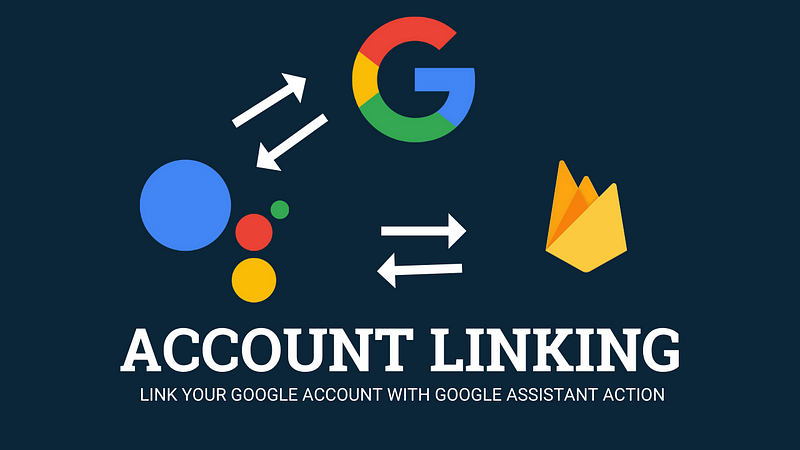
In this article, you learn how to link your Google account to Google Assistant action using Dialogflow and Cloud Functions
Overview
In this article, you learn how to link your Google account to Google Assistant action using Dialogflow and Cloud Functions
Objectives
What is Google Assistant
What is Cloud Function
Create a new action in Google Assistant
Account Linking
Create a custom action using Dialogflow
Adding Fulfilment logic to Cloud Function
Test your action
Prerequisites
Google Cloud Account
Pair of headphones or turning the volume up on your computer is recommended.
1. What is Google Assistant
Google Assistant is a personal voice assistant that offers a host of actions and integrations. From sending texts and setting reminders, to ordering coffee and playing music, the 1 million+ actions available suit a wide range of voice command needs.
2. What is Cloud Function
Google Cloud Functions is a lightweight compute solution for developers to create single-purpose, stand-alone functions that respond to Cloud events without the need to manage a server or runtime environment.
3. Creating a new action in Google Assistant
Regardless of the Assistant application, you’re building, you will always have to create an Actions project so your app has an underlying organizational unit.
Open the Actions on Google Developer Console in a new tab. You should be looking at a clean Actions console that resembles the following (If you are a new user (:
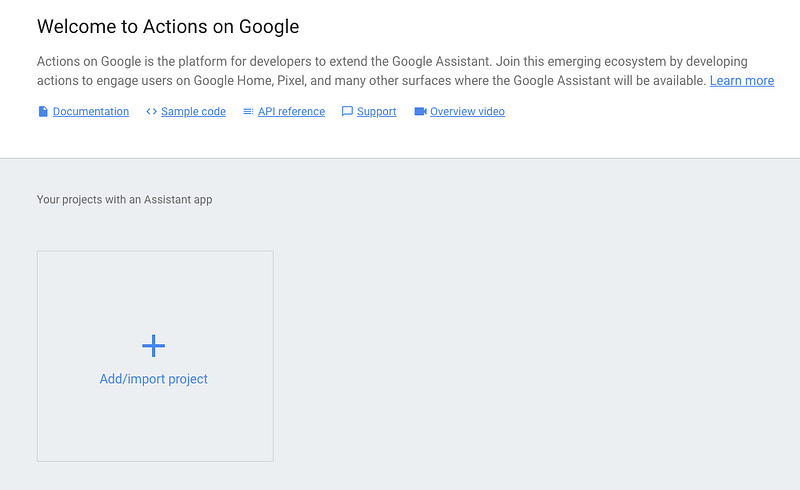
Actions on Google Console
Click Add/import project and agree to Actions on Google’s terms of service when prompted.
Click into the Project Name field and add the project name account day
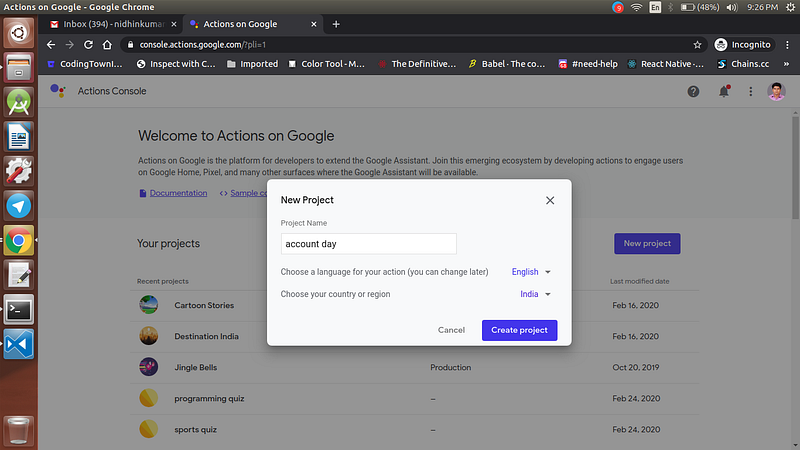
Adding project name
Once the project is created you will see a welcome screen like below

Now click Actions on Google in the top left corner to return to the homepage. Then click on the project you just created
4. Account Linking
Select the develop tab and on the left-hand side select the Account Linking option like below
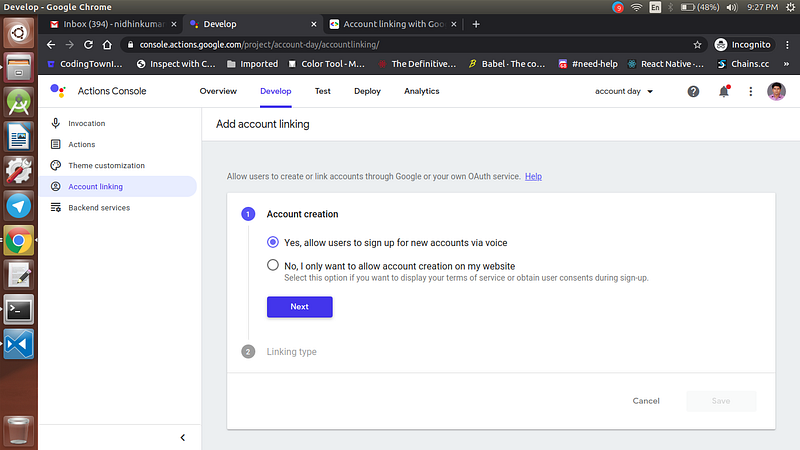
Account Linking
Click Yes to sign up for new accounts via voice and click Next
Now select the Linking type as Google Sign In
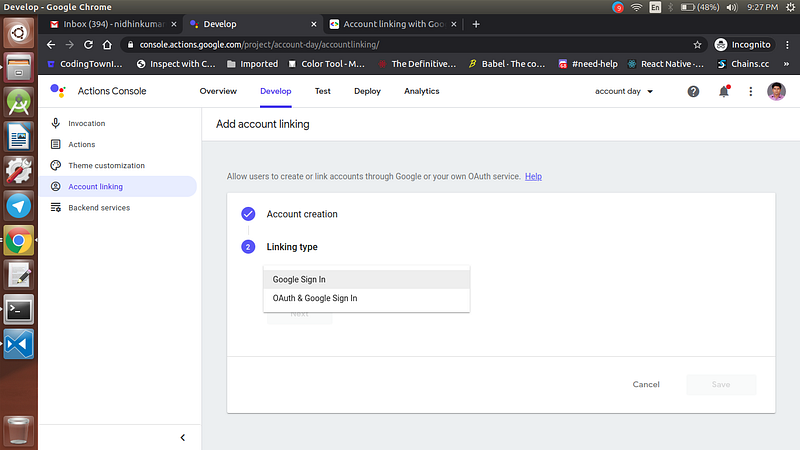
Now you will get the Google Sign-In Client Information like below
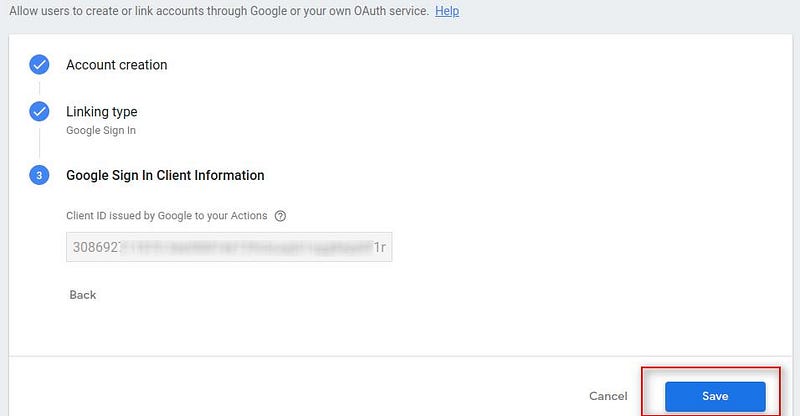
Google Sign-In Client Information
copy the credentials you will be using it in your cloud function and click Save
If your action is select for family-friendly apps then you can’t use the Account Linking option
5. Creating a custom action using Dialogflow
Now we will create a custom action using Dialogflow from the left-hand menu, select Build > Actions > Add your first action. Then select Custom Intent > BUILD
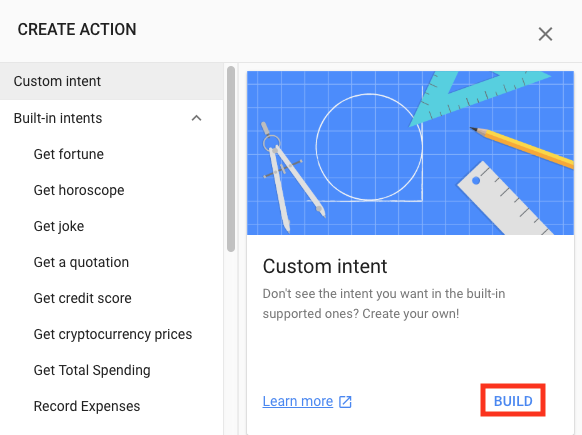
Custom Intent
This will take you to the Dialogflow console.
Click Allow when Dialogflow prompts you for permission to access your Google Account.
When you land on the Dialogflow account settings page, check the box next to Yes, I have read and accept the agreement and click Accept. You will now be brought to a Dialogflow agent creation page. Click CREATE
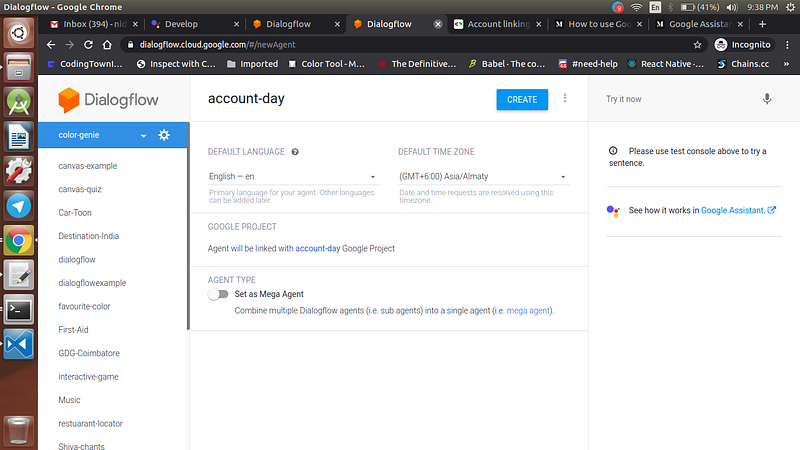
Dialogflow agent creation
An agent is an organizational unit that collects information needed to complete a user’s request, which it then forwards to a service that provides fulfillment logic.
You will now build the basic framework for fulfillment logic. This will be handled (later) by a Cloud Function, which will return a response to link your Google Account for the action
Click Fulfillment from the left-hand menu. Move the slider for Webhook to the right, setting it to Enabled.
Now enter the temporary URL https://google.com in for the URL field. You will update this URL when you build your Cloud Function. Your page should resemble the following:
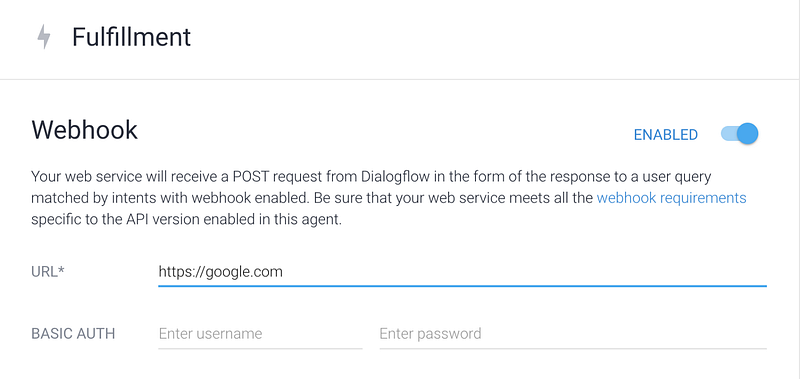
Webhook
click Intents from the left-hand menu and select Default Welcome Intent
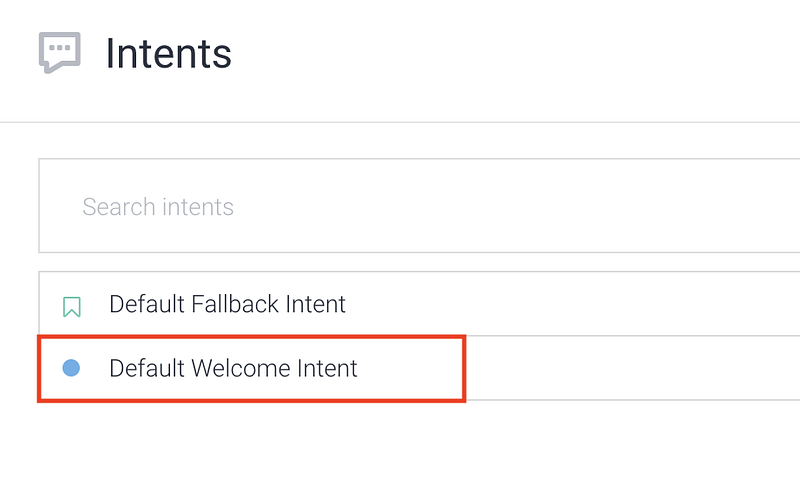
Default Welcome Intent
Scroll down to the Responses section and click the trash icon to scrap all of the default text responses
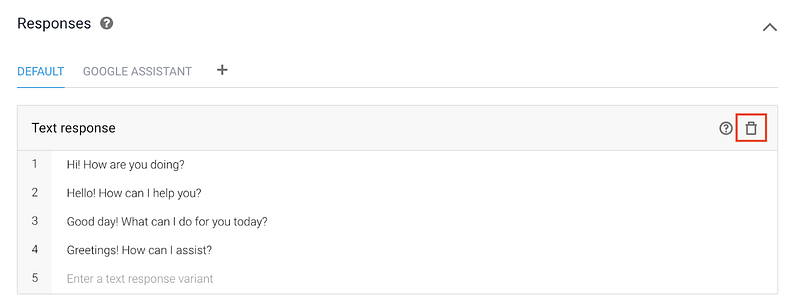
Default Responses
Now scroll down and select Fulfilment section and Enable webhook call for the intent

Enable webhook
From the left-hand menu, click on the + icon by the Intents menu item. For the Intent name field, enter Get Sign In
Scroll down and select Events and type Google Assistant Sign In

Sign In Event
Build better voice apps. Get more articles & interviews from voice technology experts at voicetechpodcast.com
Now scroll down and select Fulfilment section and Enable webhook call for the intent

Enable webhook
Now create one more intent by clicking the + icon from the left-hand menu and name it as Give Color
Scroll down and select the Training Phrase and add some training phrases like below
red is my favourite color
i like blue
set yellow
yellow
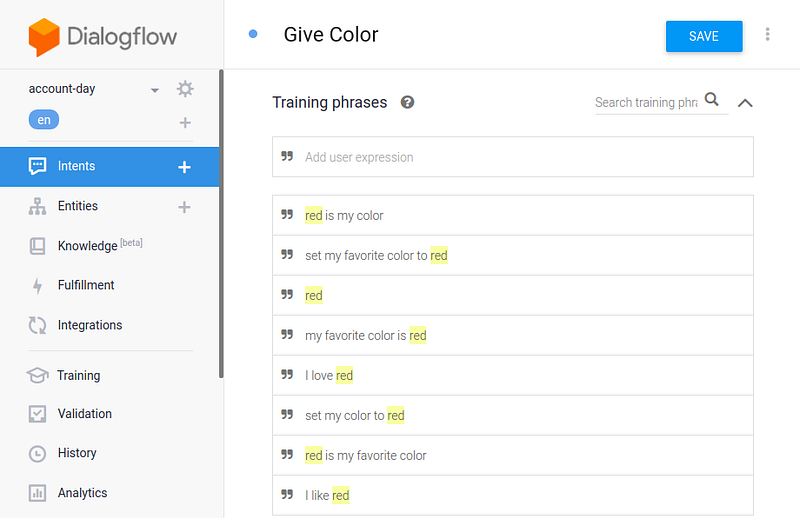
Color Intent
Now scroll down and select Fulfilment section and Enable webhook call for the intent

6. Adding Fulfilment logic to Cloud Function
Now we will create the firebase cloud function
Go to your local terminal and create a new directory named account-day and navigate to that directory
Once navigated initialize Firebase Cloud Function using the command firebase init and then select Cloud Function
Now Firebase CLI will ask you to select the project once the project is selected CLI will create the files like
index.js
package.json
Now install the actions-on-google, dotenv, firebaseadmin, firebase-functionsplugin using the command
npm i actions-on-googlenpm i dotenvnpm i firebase-adminnpm i firebase-functions
Once the plugins are installed open index.js in any text editor and remove the existing codes
Now we will import the dependencies needed for the plugin like below
const {dialogflow, SignIn, Suggestions} = require('actions-on-google');
const admin = require('firebase-admin');
const functions = require('firebase-functions');
const dotenv = require('dotenv');
Initialize the firebase admin and dotenv
dotenv.config();
admin.initializeApp();
const auth = admin.auth();
const db = admin.firestore();
db.settings({timestampsInSnapshots: true});
Create a new const variable and declare the clientid which you have copied earlier
const app = dialogflow({
clientId: // add the clientid which you have got earlier
});
Create a new Default Welcome intent like below
app.intent('Default Welcome Intent', async (conv) => {});
Add a sample response to the default welcome intent like below
app.intent('Default Welcome Intent', async (conv) => {
conv.ask(new Suggestions('Red', 'Green', 'Blue'));
conv.ask(`What's your favorite color?`);
});
Now when the user selects the color we will invoke the Give Color intent with Sign-in option
app.intent('Give Color', async (conv, {color}) => {
conv.data[Fields.COLOR] = color;
conv.ask(new SignIn(`To save ${color} as your favorite color for next time`));
});
Now it will open the Get sign-in intent like below
app.intent('Get Sign In', async (conv, params, signin) => {
if (signin.status !== 'OK') {
return conv.close(`Let's try again next time.`);
}
const color = conv.data[Fields.COLOR];
await conv.user.ref.set({[Fields.COLOR]: color});
conv.close(`I saved ${color} as your favorite color. ` +
`Since you are signed in, I'll remember it next time.`);
});
In the above snippet, we will check whether the user has given access to sign in if not it will return try again next time option
Once the sign-in is successful we will get the user profile data from firebase auth as well as in Firestore database
For that, we will be using middleware like below
app.middleware(async (conv) => {
const {email} = conv.user;
if (!conv.data.uid && email) {
try {
conv.data.uid = (await auth.getUserByEmail(email)).uid;
} catch (e) {
if (e.code !== 'auth/user-not-found') {
throw e;
}
// If the user is not found, create a new Firebase auth user
// using the email obtained from the Google Assistant
conv.data.uid = (await auth.createUser({email})).uid;
}
}
if (conv.data.uid) {
conv.user.ref = dbs.user.doc(conv.data.uid);
}
});
In the above code will check whether the user email is present or not and if available will get the user Uid from Firestore
Now in the Give Color intent, we will add the condition to get the user details
app.intent('Give Color', async (conv, {color}) => {
conv.data[Fields.COLOR] = color;
if (conv.user.ref) {
await conv.user.ref.set({[Fields.COLOR]: color});
conv.close(`I got ${color} as your favorite color.`);
return conv.close(`Since you are signed in, I'll remember it next time.`);
}
conv.ask(new SignIn(`To save ${color} as your favorite color for next time`));
});
Now we will add the condition to check whether the user is logged in or not in the Default Welcome Intent
app.intent('Default Welcome Intent', async (conv) => {
if (conv.user.verification !== 'VERIFIED') {
return conv.close(`Hi! You'll need to be a verified user to use this sample`);
}
conv.ask(new Suggestions('Red', 'Green', 'Blue'));
conv.ask(`What's your favorite color?`);
});
Now in the Default Welcome Intent, we will add the condition to get user profile details as well as the color that the user has said like below
app.intent('Default Welcome Intent', async (conv) => {
// Account Linking is only supported for verified users
// https://developers.google.com/actions/assistant/guest-users
if (conv.user.verification !== 'VERIFIED') {
return conv.close(`Hi! You'll need to be a verified user to use this sample`);
}
const {payload} = conv.user.profile;
const name = payload ? ` ${payload.given_name}` : '';
conv.ask(`Hi${name}!`);
conv.ask(new Suggestions('Red', 'Green', 'Blue'));
if (conv.user.ref) {
const doc = await conv.user.ref.get();
if (doc.exists) {
const color = doc.data()[Fields.COLOR];
return conv.ask(`Your favorite color was ${color}. ` +
'Tell me a color to update it.');
}
}
conv.ask(`What's your favorite color?`);
});
Now go to Firebase console and select the project you have created in AoG and Go to settings > Service accounts > Firebase Admin SDK > Node.js > Generate the new private key
Once the private key is downloaded rename it to service-account.json
In the Firebase console click Database and select Firestore database and click start in test mode
Now deploy the cloud function using the command
firebase deploy--project {PROJECT_ID} //get the PROJECT_ID from Dialogflow console settings
Copy the webhook URL once it is deployed and paste the webhook URL in Dialogflow
7. Test your action
Once added test your application you will get the output like below as well as a confirmation email to the email id which you have tried to login
Feel free to grab the source code for the cloud function
Resource Links
AoG Resource — https://developers.google.com/assistant/identity/google-sign-in#nodejs
AoG Nodejs-Github — https://github.com/actions-on-google/dialogflow-google-sign-in-nodejs
Congratulations!
You have learned how to link your Action with Google Account. Happy Learning :)
Subscribe to my newsletter
Read articles from nidhinkumar directly inside your inbox. Subscribe to the newsletter, and don't miss out.
Written by
